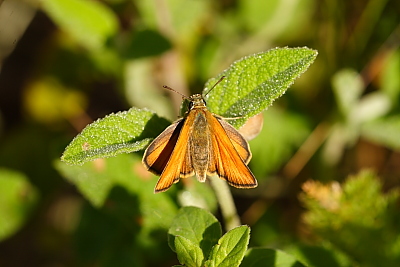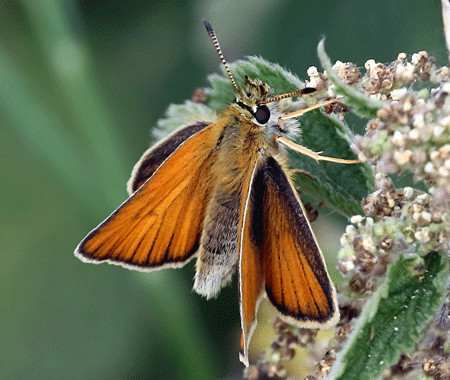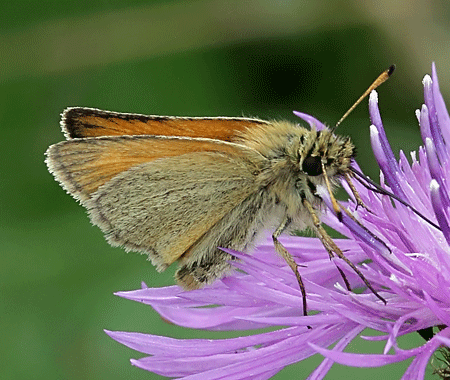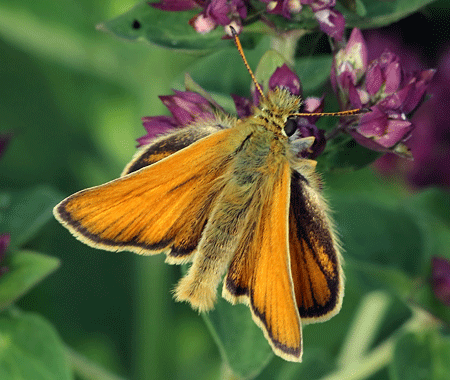Essex Skipper: A Portrait of the Darting Butterfly:With a wingspan ranging from 26 to 30 millimeters, the Essex Skipper is a strikingly small butterfly that has captivated the attention of naturalists since its recognition as a distinct species in 1889. Prior to this, it had been mistaken for the Small Skipper due to the similarities in their outward appearances. Yet, a closer examination reveals several key differences. One of the most noticeable distinctions lies in the black undersides of its antennae—black in the Essex Skipper, whereas the Small Skipper exhibits orange-colored antennae. Additionally, the male Essex Skipper’s sex brand is short and does not cross a vein, unlike its counterpart, where the sex brand does cross the vein.


This butterfly is widespread across the southeastern regions of England and has been gradually expanding its range to the north and west. It thrives in a variety of habitats that feature long grasses, including road verges, marshlands, chalk grasslands, abandoned fields, and woodland clearings.
The Essex Skipper, with its quick, darting flight, is a common sight throughout England and Wales. Its wings—vibrant orange-brown—are held with the forewings angled above the hindwings. The males possess a fine black line that runs through the center of the forewings, running parallel to the leading edge. The Small Skipper, a close relative, can easily be confused with the Essex Skipper, though it lacks the black-tipped antennae (which are most apparent when viewed head-on) and has a longer, more angled scent brand on the forewings.
The Essex Skipper often flutters alongside the Small Skipper, and the two species are frequently found together. Their similar appearances have led to a historical oversight of the Essex Skipper in ecological studies, making it the last British resident butterfly species to be formally described in 1889. Over recent decades, the distribution of the Essex Skipper has dramatically increased, with its range in Britain more than doubling.
Life Cycle and Development
The adult Essex Skipper is typically on the wing during the warmer months of July and August. Remarkably, this species overwinters in its egg form. The eggs are laid on low or tall herbaceous plants, often within a rolled leaf sheath on the stem of a grass. The larvae hibernate within the eggshell before emerging in the spring. Once hatched, the young caterpillars begin feeding, and within a few days, they spin the edges of a leaf blade together to create a tubular retreat. Emerging from this shelter, they feed on the tender tips of the leaves. By late May, the larvae pupate, encased in a silk cocoon woven within the leaf blades at the base of their food plant.



Larval Food Plants
The Essex Skipper’s larvae feed primarily on species of grasses, including Cocksfoot (Dactylis glomerata), Creeping Soft-grass (Holcus mollis), and possibly other grass species.
Nectar Sources
Adult Essex Skippers are known to frequent a variety of nectar-rich plants, including Marjoram, thistles, and knapweeds, where they indulge in the sugary nectar that sustains their active flight.
Habitat
This butterfly species prefers tall, dry grasslands situated in open, sunny locations, particularly road verges, woodland rides, acid grasslands, and coastal marshes. It is commonly found in rough grasslands and embankments, thriving in unimproved dry grassland and field margins. The Essex Skipper was first reported in Wexford in 2006 and is now found in two distinct populations within Kildare and Wexford, as documented by Wilson et al. (2008) and Harding & Jacob (2013).
In flight, the Essex Skipper is a swift and energetic flier, skimming low across the grass in sunlit locations. When not in flight, it may be seen perching for long stretches on warm, bare patches of ground. The territorial males often perch on or near conspicuous flower patches, where they await the approach of females, who seek suitable sites for oviposition.
Distinguishing Features
Though strikingly similar to the Small Skipper, the Essex Skipper can be readily identified by its distinctive black-tipped antennae, as if dipped in ink, a feature absent in the Small Skipper. Additionally, the male Essex Skipper is identifiable by the sex brand on its forewings, a short line of specialized scent scales that distinguishes it from the female.
